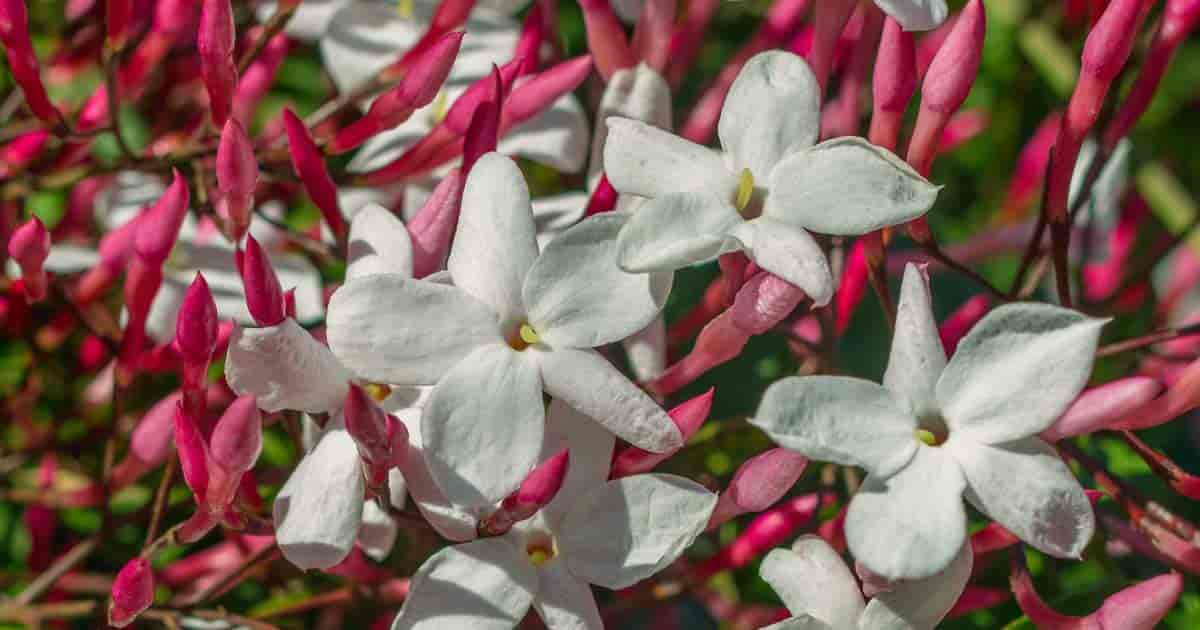The Jasminum polyanthum [jaz-MIN-ee-uh pol-ee-ANTH-um] is a climbing shrub that produces fragrant white blooms.
It’s a semi-deciduous evergreen vine (in some locations) native to Burma and China and suitable for a wide range of climates.

This fast growing vine flowers nicely and finds use for covering walls or fences. The versatile plant belongs to the Jasmine plant genus and the Oleaceae family of plants.
You may find it listed under one of its common names:
- Pink jasmine
- Winter jasmine (Jasminum Nudiflorum also)
- Jasmine
The hardy climber is a popular choice, due to its fast growth rate, lovely flowers, and lack of disease or pest problems.
Jasminum Polyanthum Plant Care
Size and Growth
This long Jasmine vine is not a strong climber. The stems will continue to grow for quite a few feet if grown along a trellis or fence.
When placed in a pot, a wireframe or trellis is often used in the to the pot to support the twining vine.
The plant grows best in USDA hardiness zone 8 to 11. If you live in the Midwest or Northern US, grow the plant indoors during the winter months.
Flowering and Fragrance
The flowers typically arrive in late winter / early spring and come all at once. The plant may flower once or twice per year and produces pink flower buds.
The blooming jasmine features white flowers with an intense, sweet scent.
Light and Temperature
When choosing a spot for this climbing shrub, try to give it lots of sunlight while avoiding direct sunlight.
Like many plants, the dark green leaves will burn if placed in full sun, especially during the summer months.
It also grows well in moderate climates. If the temperature is too cold or too hot, the plant will suffer.
Do not let the plant sit outdoors in temperatures dropping below 50° degrees Fahrenheit in the winter.
If you want it to keep flowering, avoid temperatures that drop below 60° degrees Fahrenheit.
Watering and Feeding
You should water the plant regularly throughout the entire year.
In the summer, mist the leaves every day with water from a spray bottle. The mist helps keep the plant hydrated.
From (late winter or early spring) March to September, apply a liquid fertilizer when watering.
Use the fertilizer once every two weeks to promote healthy growth.
Soil and Transplanting
With the right care, it can last for years. Use a well drained nutrient-rich soil or potting compost.
It can be grown in a container and repotted each spring after the flowers have mostly died. You may find Polyanthum growing in hanging baskets that are fine for one season but will need repotting.
Maintenance & Grooming
There are a couple of grooming tasks that needed to control the growth of this plant.
First, trim it back in the early spring, to keep the stems from getting too long.
Pinch out the tips during the spring to help encourage thicker foliage growth.
With trimming and pinching, you can keep the plant from growing too long and help it become a little thicker.
How to Propagate Jasminum Polyanthum Pink Jasmine
Propagating is possible with cuttings. When the plants finish flowering in March or April, take cuttings.
The best cuttings are not too “new” or too woody. Cut just under a pair of leaves, and pinch out the tender growing tip.
Drip the bottom of the cutting in rooting hormone powder like rootone.
Place two or three cuttings in a 4″ or 5″ inch pot filled with nutrient-rich soil and cover the pot with a plastic bag.
After 10 to 14 days, the cuttings should take root. Remove the plastic bag and place the pot in a brighter area.
When the plants get a little bigger, transplant them to permanent homes.
Jasminum Polyanthum Pests or Disease Problems?
The jasmine polyanthum is considered an invasive species in New Zealand and Australia.
As the plant is hardy and grows layers of stems covering a long distance, it can smother other plants and vegetation.
When growing here are a couple of issues to watch out for.
If the leaves start to dry out and wither, the soil is likely too dry. Direct sunlight can also cause leaves to dry out.
Try moving the plant and increasing the watering.
If the leaves are sticky and deformed, the plant may be suffering from an aphid attack.
Spray the leaves with an insecticide (Neem Oil) to resolve the problem.
Spider mites may also attack the plant (use Neem Oil sprays). Keeping the plant moist with daily misting helps control spider mite infestations.
Suggested Uses For Polyanthum Pink Jasmine
As the plant needs plenty of sunlight, it should be placed in a south-facing window, if grown indoors.
Keep in mind the plant can get wide when growing on a wire hoop. Some homeowners plant it along a chain link fence.
Another option is to plant a potted one in a greenhouse. Besides plenty of sunlight, it needs lots of moisture.
If you don’t keep it in a greenhouse, remember to mist it daily.
[source]
